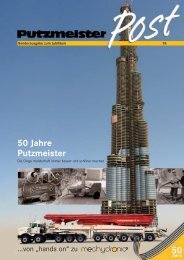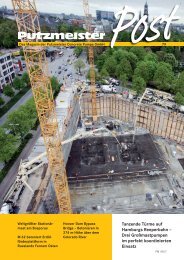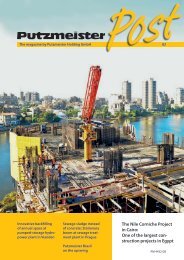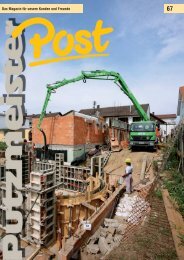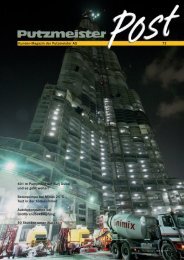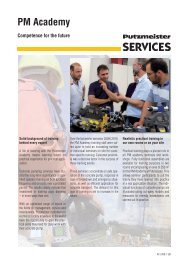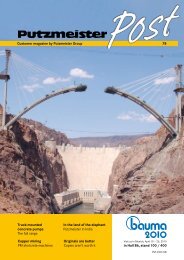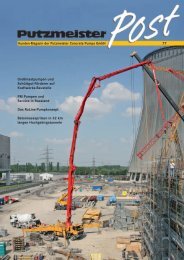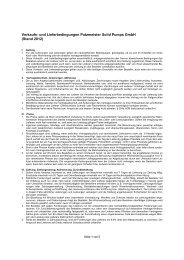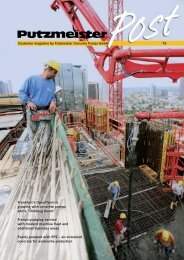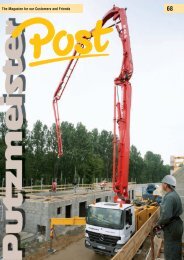Dancing Towers on Hamburg's Reeperbahn - Putzmeister
Dancing Towers on Hamburg's Reeperbahn - Putzmeister
Dancing Towers on Hamburg's Reeperbahn - Putzmeister
Create successful ePaper yourself
Turn your PDF publications into a flip-book with our unique Google optimized e-Paper software.
On site On site<br />
MXKD 50 and BSA 110 HP D<br />
c<strong>on</strong>creting the underground<br />
rail stati<strong>on</strong> in Yenikapı / Istanbul<br />
ISTANBUL<br />
Historic<br />
city center<br />
MXKD 50 at the centre<br />
of an archaeological sensati<strong>on</strong><br />
Yenikapı<br />
The c<strong>on</strong>structi<strong>on</strong> of a new, state-of-the-art<br />
transport interchange is supposed to be underway<br />
here, in Yenikapı, <strong>on</strong> the European<br />
side of the Bosporus: a major rail transit<br />
stati<strong>on</strong> to serve the 15-milli<strong>on</strong> metropolis of<br />
Istanbul. When the ground was broken back<br />
in 2004, nobody thought that the project<br />
would be set back by the discovery of an important<br />
transport hub from C<strong>on</strong>stantinople‘s<br />
past.<br />
First of all, the excavati<strong>on</strong> of the pit for the<br />
new, 21st century subway stati<strong>on</strong> <strong>on</strong> the<br />
Marmaray tunnel line unearthed a series of<br />
ancient walls. As it turned out, these bel<strong>on</strong>ged<br />
to an important Byzantine trading port,<br />
a transport hub of the “global world” dating<br />
back to around 400 AD. The “Port of Theodosius”<br />
– named after the last ruler of the<br />
Eastern Roman and Byzantine Empire – c<strong>on</strong>tained<br />
the remains of, to date, more than 30<br />
ships, the largest single discovery of ship<br />
relics anywhere in the world. Am<strong>on</strong>g them<br />
were four Byzantine drom<strong>on</strong>s, the oldest<br />
warships ever to have been discovered. They<br />
must have been sunk around 1000 AD.<br />
Sea of Marmara<br />
Bosporus<br />
Marmaray<br />
tunnel secti<strong>on</strong><br />
What was a great moment for archaeology<br />
(Yenikapı is the largest urban excava ti<strong>on</strong><br />
and <strong>on</strong>e of the most signifi cant fi nds in Turkey)<br />
has caused developers to suffer serious<br />
time delays and, of course, to incur enormous<br />
costs.<br />
Yenikapı is situated <strong>on</strong> the southern shore<br />
of Istanbul‘s old town <strong>on</strong> the Sea of Marmara.<br />
With the future c<strong>on</strong>structi<strong>on</strong> of its major<br />
rail transit stati<strong>on</strong> serving the “Marmaray”<br />
undersea tunnel under the Bosporus strait,<br />
Yenikapı is intended to offer passengers a<br />
means of changing from overground to un-<br />
35 36<br />
derground trains. Originally, a new regi<strong>on</strong>al<br />
train stati<strong>on</strong> had also been planned in<br />
order to c<strong>on</strong>nect suburban commuter traffi<br />
c to the East-West network. However, this<br />
aspect of the project had to be changed:<br />
such is the importance of the ancient port,<br />
the local heritage trust decided that it<br />
would have to remain exactly where it is.<br />
q Discovery site of <strong>on</strong>e<br />
of the wooden ships<br />
37<br />
In February 010, the time had fi nally<br />
come: an MXKD 50 <strong>on</strong> a 15 m lattice<br />
tower and a BSA 110 HP D stati<strong>on</strong>ary<br />
c<strong>on</strong>crete pump began c<strong>on</strong>creting the<br />
Yenikapı railway stati<strong>on</strong>.<br />
This is the <strong>on</strong>ly stati<strong>on</strong> of the new Marmaray<br />
tunnel line being c<strong>on</strong>structed using the cutand-cover<br />
method. Its bottom surface mea-<br />
t Pipeline fastenings<br />
in the horiz<strong>on</strong>tal secti<strong>on</strong><br />
ZX 1 5/5”-1 0 bar<br />
sures approximately 300 m l<strong>on</strong>g and 35 m<br />
wide. For the c<strong>on</strong>creting of the foundati<strong>on</strong>s,<br />
it was divided into a total of 29 secti<strong>on</strong>s.<br />
Each secti<strong>on</strong> – approximately 10 x 35 m<br />
and 2 m thick – is being c<strong>on</strong>creted m<strong>on</strong>olithically<br />
in multiple layers of 40 cm. Each<br />
layer c<strong>on</strong>tains some 120 m 3 c<strong>on</strong>crete, which<br />
produces an average of 650 m 3 for each of<br />
the 29 secti<strong>on</strong>s.<br />
.<br />
Technical data BSA 110 HP D<br />
Output up to 102 m 3 /h<br />
C<strong>on</strong>crete pressure up to 220 bar<br />
Engine 330 kW Diesel<br />
Delivery cylinder Ø 200 mm<br />
Stroke 2100 mm<br />
q While some go to work with heavy machinery, others require rather more delicate tools, such as a trowels and brushes.<br />
In the foreground are unearthed fragments of the ancient harbour wall.<br />
18 PM 4307 GB PM 4307 GB 19<br />
38<br />
39



